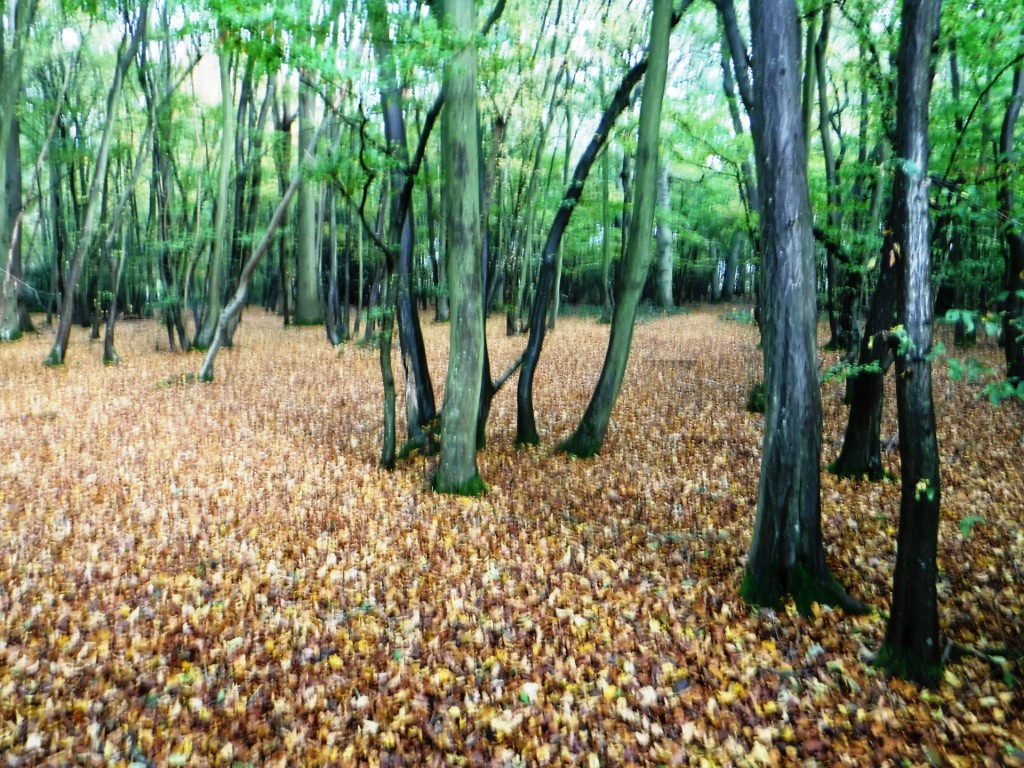
Total monthly rainfall: 36 mm. with a maximum daily rainfall of 14.5 mm (30th October). Measurable rain fell on only 6 days of the month, leaving our ponds at very low levels. Maximum temperature on the warmest day was 22°C on the 10th. Maximum temperature on the coldest day was 7°C on the 30th. There were, however, only 11 days when 100% cloud-cover occurred, and there were strong winds on the 11th and 12th.
We had only one new wildflower sighting this month, and that was a small cluster of centaury, obviously overlooked by us earlier in the year. It appears most years, but rarely in the same place, and grows among other plants, this year being lakeside among fleabane.
-
 Autumn colours on woodland floor
Autumn colours on woodland floor
Autumn colours on woodland floor
Autumn colours on woodland floor
-
 Flounced chestnut moth
Flounced chestnut moth
Flounced chestnut moth
Flounced chestnut moth
-
 Hornbeam in autumn colours beside pond
Hornbeam in autumn colours beside pond
Hornbeam in autumn colours beside pond
Hornbeam in autumn colours beside pond
-
 Spider web on a misty morning
Spider web on a misty morning
Spider web on a misty morning
Spider web on a misty morning
https://www.kentfieldclub.org.uk/news/little-barton-farm-wildlife-notes/october-2018#sigProId6e84868aa8
Other species first-sightings were two moths, a flounced chestnut on a lighted porch wall on the 9th, and a beautiful plume moth to light indoors on the 17th, both being new to our site. Additionally, on the 26th, we discovered a new species of crane-fly on our French window (either Tipula rufina or Tipula staegeri, which are difficult to tell apart from just a photograph). We have to thank Keith Palmer and Laurence Clemens respectively for assisting in the identification of these insects. Finally, also on the 26th, we found a dark bush cricket on top of the compost bin.
Wildflowers still left on site and in flower are yarrow, knapweed, fleabane, red clover, dandelion, white and red deadnettle, redshank, and rough hawkbit. We lost great willowherb on October 4th, and water mint on the 9th. We also removed the last spiny oxtongue and dead-headed the last creeping thistle on the 27th.
Of the dragonflies on-site during October, we saw the last willow emerald damselflies on the 9th, and southern hawker on the 21st. With cold, cloudy weather on the last five days of the month, we saw our last migrant hawker and common darter on the 25th. It is probable that one or other of these will re-appear during November if the weather improves.
The five butterfly species which survived into October were last seen as follows: common blue on the 10th, peacock (14th), red admiral (21st), small copper (23rd), and speckled wood (25th). Again, it is possible for one or more of these to return in November.
A dramatic feature of autumn is the appearance of spiders’ webs on sunny, misty mornings. One such day was October 5th, when, after successive years of trying, we finally managed to produce a photograph doing justice to the occasion – the secret being to find a dark background, and reduce the distance shown in the picture! You just have to imagine this scene reproduced fifty-or-so times around the lake. October 15th represents halfway through meteorological autumn. On this day there was little autumn colour among the woodland trees, because most of those colours were on the woodland floor, deposited there largely by the wind. By the end of the month there were still more trees showing green than displaying autumn colours.
Development of autumn by flora occurred as follows: Ivy flowered on the 1st, and holly berries were ripe on the 15th. Hornbeam leaves turned orange on the 4th; field maple also orange on the 12th; hawthorn turned yellow and orange on the 15th; ash turned yellow on the 20th; wild cherry turned red and brown on the 25th, and horse chestnut turned brown on the 30th. Finally, poplar became bare on the19th – the only tree to do so this month.

